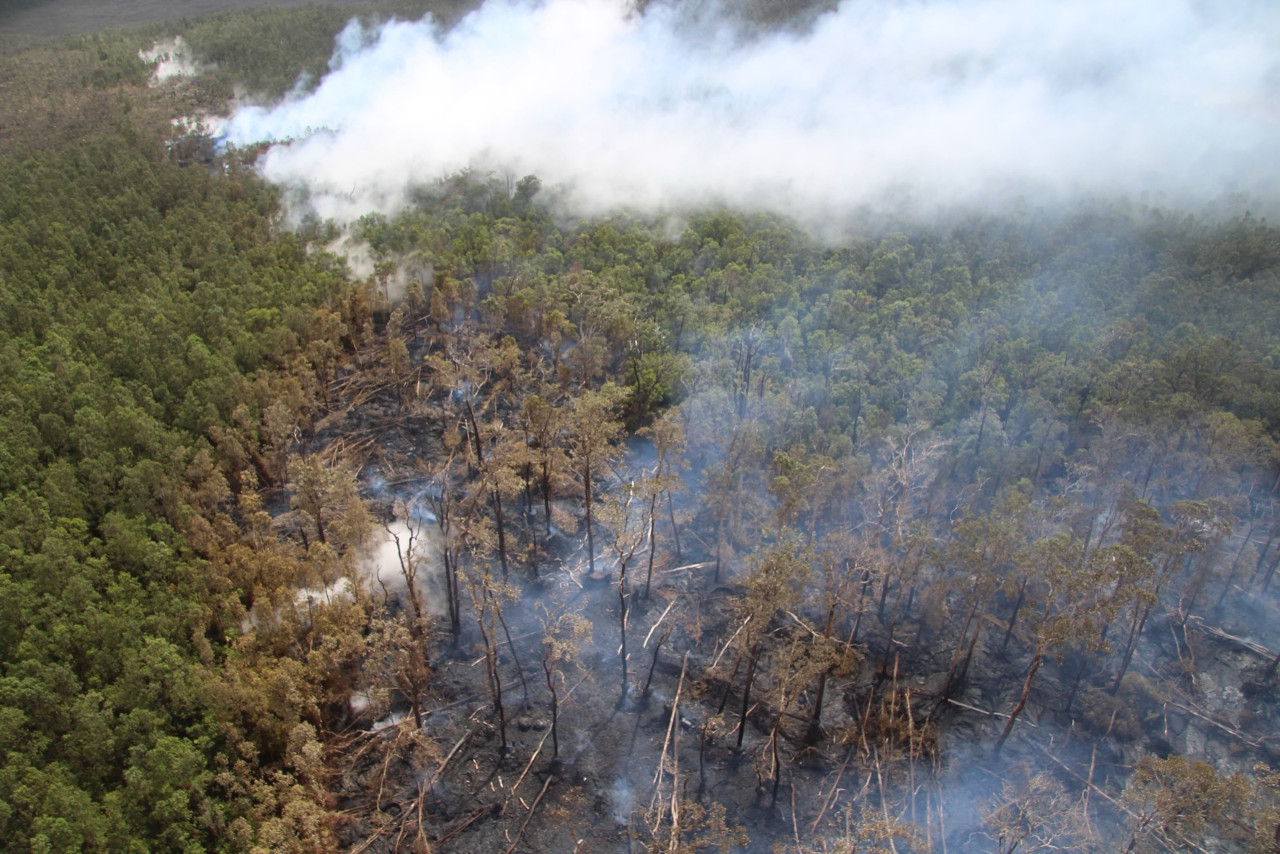
USGS: “Dead trees and vegetation are surrounded by freshly erupted lava west of Nāpau Crater on the remote middle East Rift Zone of Kīlauea, within Hawaiʻi Volcanoes National Park. This eruption likely occurred between approximately 9–10 p.m. HST on September 15.” (USGS photo by M. Zoeller)
(BIVN) – Scientists confirmed Monday that Kīlauea volcano erupted briefly overnight on the middle East Rift Zone.
The USGS Volcano Alert Level for ground-based hazards at Kīlauea remains at WATCH and the Aviation Color Code remains at ORANGE at this time, the Hawaiian Volcano Observatory says.
Although scientists could not visually confirm the eruption last night, the USGS HVO did issue a Volcanic Activity Notice at 12:23 a.m., upgrading the Kīlauea alert level from ADVISORY to WATCH, and reporting that “infrasound instruments detected a strong signal typical of gas or steam venting and seismometers in the middle East Rift Zone are recording weak, sustained low frequency tremor.”
At the time of the USGS HVO notice, Kīlauea was experiencing heightened unrest, as an apparent magma intrusion was occurring on the upper-to-middle East Rift Zone.
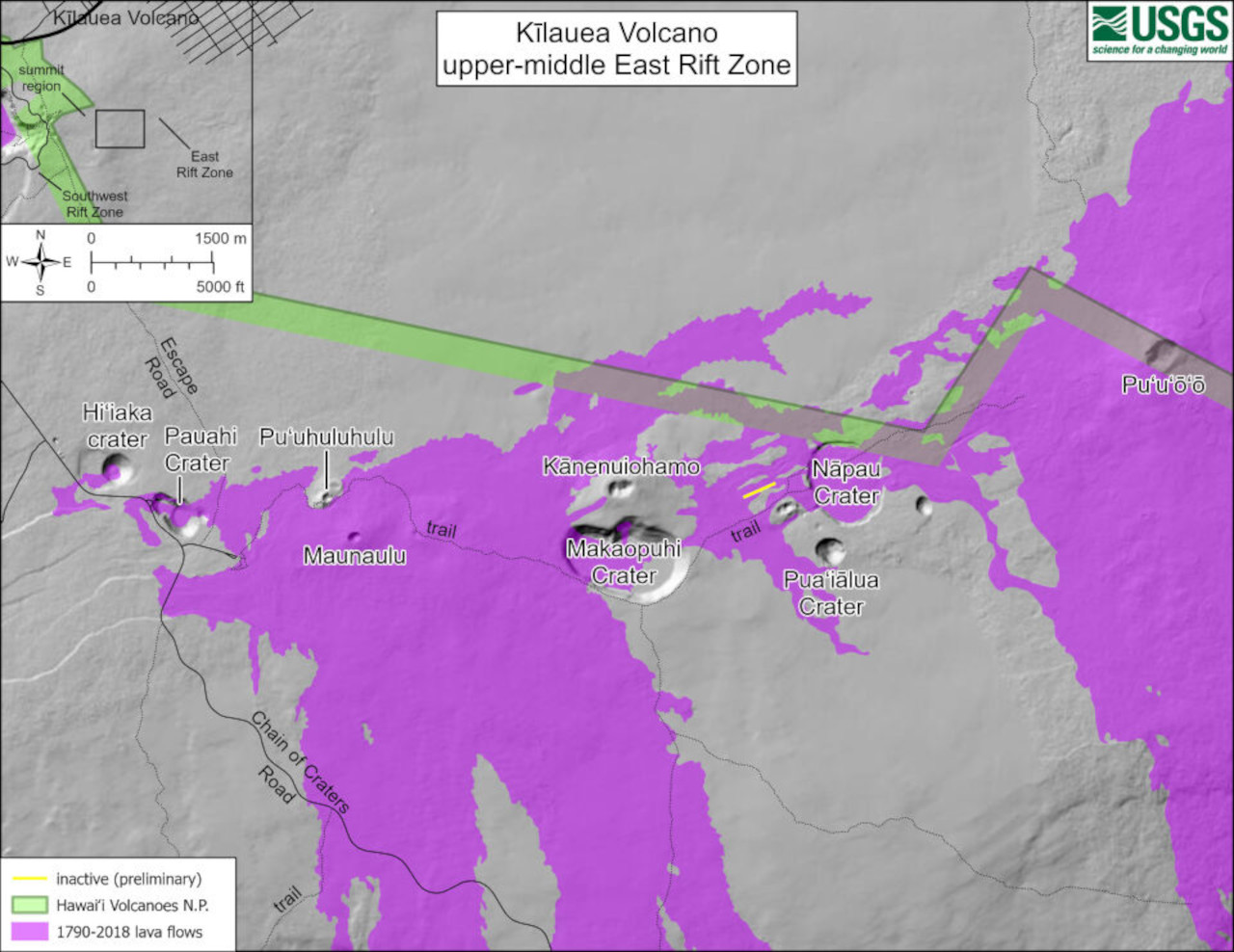
This reference map depicts the approximate location of the fissures that erupted from the Kīlauea middle East Rift Zone, likely between approximately 9:00 and 10:00 p.m. HST on Sunday 15, 2024, in a remote and closed area of Hawaiʻi Volcanoes National Park. Small lava pads erupted from two fissure segments in a couple hundred meters (hundred yards). This is a preliminary map; an updated map will be published when further information is available.
On Monday morning, the USGS HVO issued another Volcanic Activity Notice, with the following summary:
Kīlauea volcano erupted briefly last night just west of Nāpau Crater on the middle East Rift Zone. This eruption, which is now over, likely occurred between approximately 9:00 and 10:00 p.m. HST on Sunday 15, 2024, in a remote and closed area of Hawaiʻi Volcanoes National Park. Chain of Craters Road, which is closed, is located downslope and downwind of the new fissures. Continued degassing from the fissure system may pose a hazard to humans downwind of the eruption site. The eruption does not currently pose an immediate threat to human life or infrastructure.
The eruption took place near the National Park Nāpau campsite (east of Kānenuiohamo and Makaopuhi Crater and west of Nāpau Crater). Small lava pads erupted from two fissure segments in a couple hundred meters (hundred yards). The lava extended 50 or so meters (yards) from the fissure vents, with the uprift fissure segment being larger than the downrift fissure segment. The eruption does not appear to have impacted Napau campground, but may have partly covered the pulu (Hawaiian tree fern) station nearby. Vegetation in the eruption area was burned and sulfur dioxide continues to de-gas from the vents. Residents of nearby subdivisions reported smelling volcanic gas and other smells related to this event during the evening of September 15.
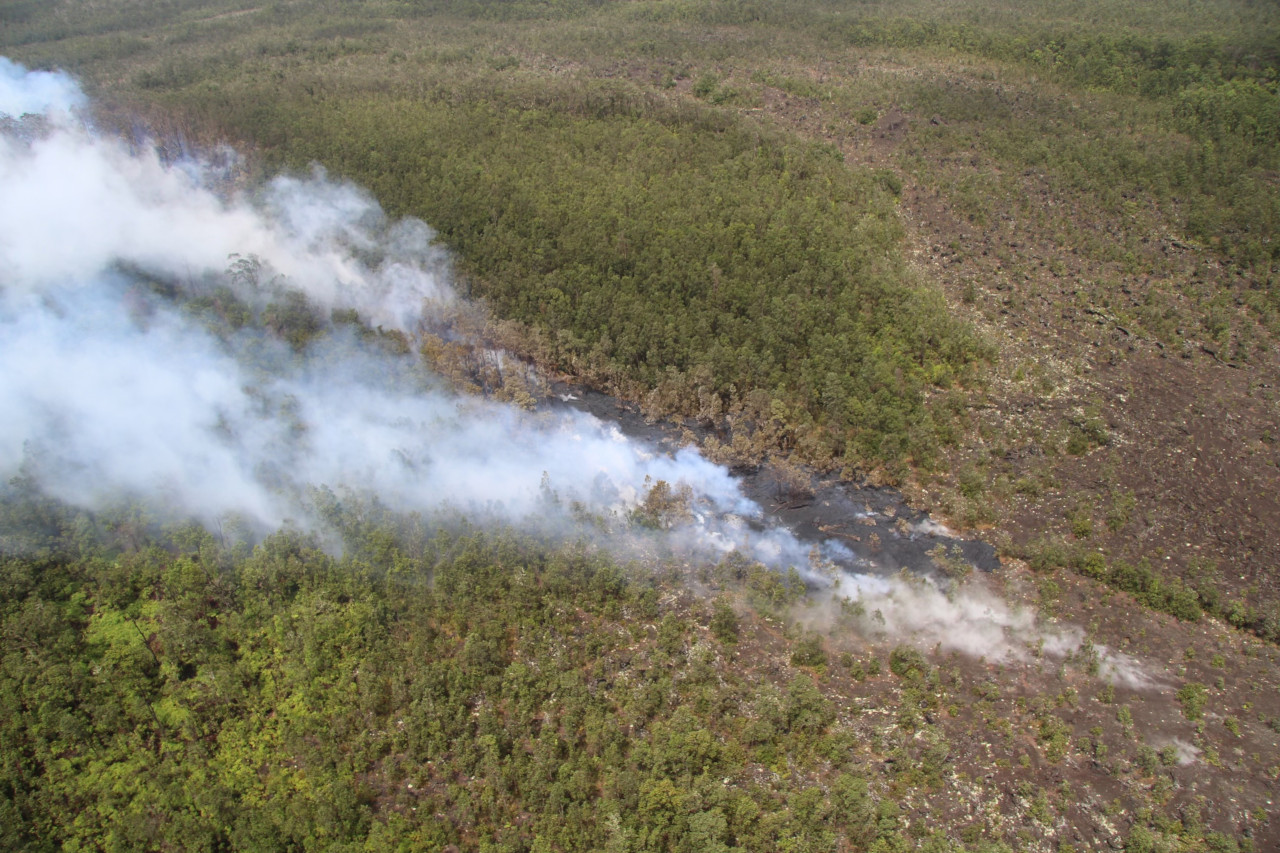
USGS: “During a USGS Hawaiian Volcano Observatory overflight at approximately 10:30 a.m. HST on September 16, geologists observed freshly erupted lava west of Nāpau Crater on the remote middle East Rift Zone of Kīlauea, within Hawaiʻi Volcanoes National Park. This eruption likely occurred between approximately 9–10 p.m. HST on September 15.”
The USGS HVO says it is continuing to closely monitor the middle East Rift Zone and in contact with Hawai‘i Volcanoes National Park and the Hawai‘i County Civil Defense Agency.
Chain of Craters Road has been closed by the National Park Service due to heightened gas emissions and volcanic unrest.
The USGS HVO also provided the following Hazard Analysis for the brief eruption:
Shallow magma movement and eruptions can produce minor to severe ground fractures and subsidence features, which can affect the landscape, human activity, and infrastructure. These ground cracks can continue to widen and offset as magma migration continues, may have unstable overhanging edges, and should be avoided.
Additional ground cracking and outbreaks of lava around the active fissures are possible at any time, or, existing fissures can be reactivated. Hawaiian lava flows generally advance slowly downslope and can be avoided by people. They can destroy everything in their paths including vegetation and infrastructure—which can cut off road access and utilities. Hazards associated with active or recent lava flows include hot and glassy (sharp) surfaces that can cause serious burns, abrasions, and lacerations upon contact with unprotected or exposed skin; uneven and rough terrain can lead to falls and other injuries; hot temperatures that can cause heat exhaustion or dehydration, or in heavy rain can produce steamy ground-fog that can be acidic, severely limiting visibility and sometimes causing difficulty breathing.
If new lava flows cover and burn vegetation and soil, they can ignite natural gas pockets in the subsurface, which can cause methane explosions. These explosions can blast lava fragments up to several meters (yards) away and can be hazardous to observers.
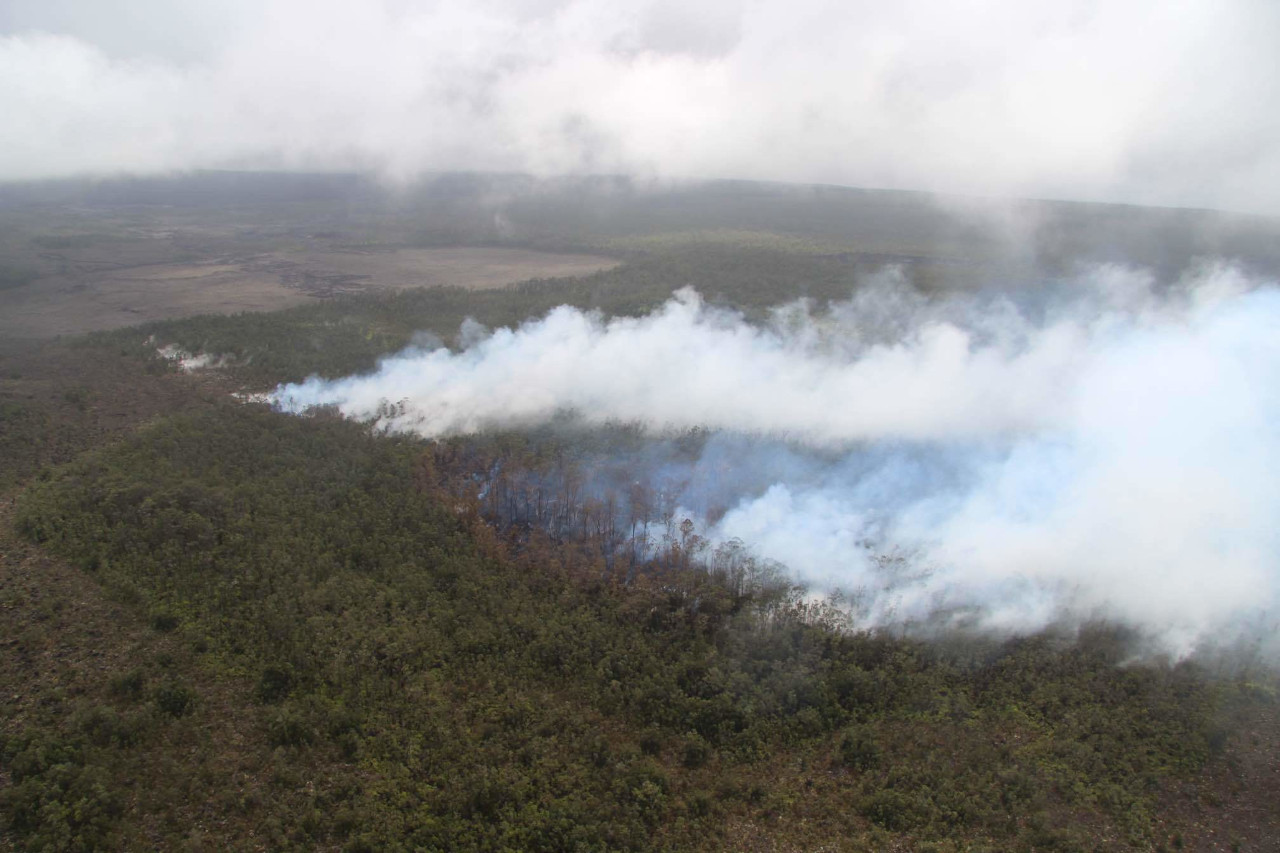
USGS: “An east-facing view showing Nāpau Crater in the background and the recent eruption in the foreground. This brief eruption took place on the middle East Rift Zone of Kīlauea over about an hour during heavy rain that obscured webcam views the evening of September 15, 2024.” (USGS photo by M. Zoeller)
Pele’s hair and other lightweight volcanic glass fragments from lava fountains and spattering will fall downwind, dusting the ground within a few hundred meters (yards) of the vent. High winds may waft lighter particles and transport them greater distances downwind. Exposure to these volcanic particles can cause skin and eye irritation.
High level of volcanic gas—primarily water vapor (H2O), and sulfur dioxide (SO2)—are emitted during eruptions and can have far-reaching effects downwind. As SO2 is released from, it reacts in the atmosphere to create the visible haze known as vog (volcanic smog) that has been observed downwind of eruptive vents. Vog creates the potential for airborne health hazards to residents and visitors, damages agricultural crops and other plants, and affects livestock. For more information on gas hazards at the summit of Kīlauea, please see (this website). Vog information can be found at vog.ivhhn.org.
Hazards also remain around Kīlauea caldera from Halemaʻumaʻu crater wall instability, ground cracking, and rockfalls that can be enhanced by earthquakes within the area closed to the public. This underscores the extremely hazardous nature of the rim surrounding Halemaʻumaʻu crater, an area that has been closed to the public since early 2008.
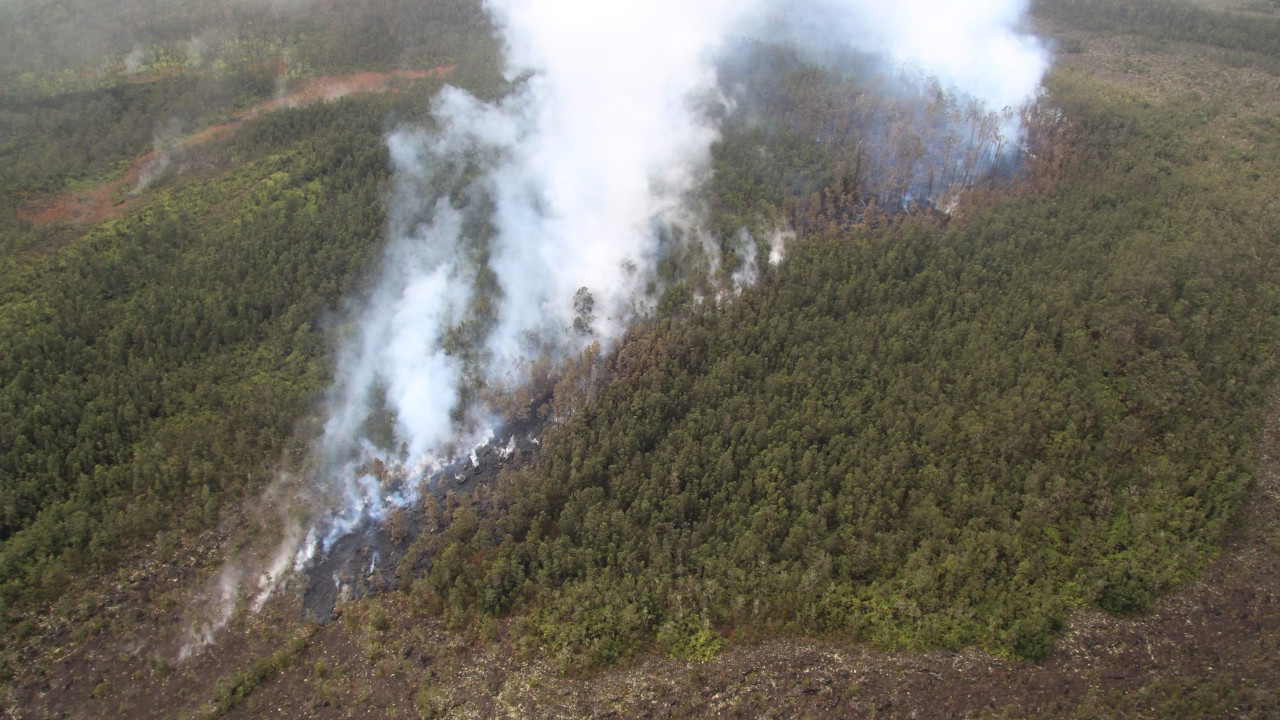

by Big Island Video News12:29 pm
on at
STORY SUMMARY
HAWAIʻI VOLCANOES NATIONAL PARK - The eruption occurred last night, just west of Nāpau Crater, near the Nāpau campsite within the National Park.